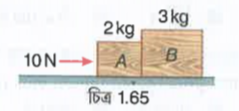যদি কোনো অনুভূমিক দণ্ডের দু- প্রান্তে পরস্পর বিপরীত অভিমুখে দুটি বল F1 এবং F2 (F2>F1) অনুভূমিকভাবে প্রয়োগ করা হয় তবে দণ্ডের মধ্যবিন্দুতে কত টান উৎপন্ন হবে? (দণ্ডের ভর M)
F1+F22
F2−F12
(F2−F1)
(F2+F1)
The correct Answer is:A
Topper's Solved these Questions
- নিউটনের গতিসূত্রBOOK - CHAAYA PRAKASHINI (BENGALI)CHAPTER - নিউটনের গতিসূত্রEXERCISE - EXERCISE
90 Videos
- নিউটনীয় মহাকর্ষ ও গ্রহ -উপগ্রহের গতিBOOK - CHAAYA PRAKASHINI (BENGALI)CHAPTER - নিউটনীয় মহাকর্ষ ও গ্রহ -উপগ্রহের গতিEXERCISE - WBCHSE
5 Videos
- বৃত্তীয় গতিBOOK - CHAAYA PRAKASHINI (BENGALI)CHAPTER - বৃত্তীয় গতিEXERCISE - EXERCISE
32 Videos
Similar Questions
A ও B ব্লক দুটির ভর যথাক্রমে 2 kg ও 3 kg | মসৃণ অনুভূমিক টেবিলের ওপর ব্লক দুটিকে পরস্পরের সংস্পর্শে রাখা হল [চিত্র 1.65]।10 N বল A ব্লকের ওপর অনুভূমিকভাবে প্রয়োগ করা হলে A ব্লক B ব্লকের ওপর যে বল প্রয়োগ করে তা হল-

View Solutionপৃথিবীর গড় ঘনত্ব ও ব্যাসার্ধের সম্পর্ক কী?
View Solutionকম্পাঙ্ক বলতে কি বোঝ?
View Solutionद्रवचालित लिफ्ट में उत्थापक बल F2 तथा आरोपित बल F1 अनुपात F2/F1 कहलाता है
View SolutionFind the magnitude of F_1 and F_2 . If F_1, F_2 make angle 30^@ and 45^@ with F_3 and magnitude of F_3 is 10 N. ("given "vecF_1 + F_2 = vecF_3)
View Solutionबहुलक ज्ञात करने के सूत्र l+(f1−f02f1−f0−f2)x में f1 को........ कहते हैं।
View SolutionThe function f1 and f2 are defined as follows : f1=a!+b!andf2=aa+bb for a, b > 1 and a, b in N then the correct relation is :
View SolutionShow that if f1andf2 are one-one maps from R→R, then the product f1×f2:R→R defined by (f1×f2)(x)=f1(x)f2(x) need not be one-one.
View SolutionSuppose f1andf2 are non-zero one-one functions from R→R. is f1f2 necessarily one-one? Justify your answer. Here, f1f2:R→R is given by (f1f2)(x)=f1(x)f2(x) for all x∊Rdot
View SolutionSuppose f1andf2 are non=zero one-one functions from R→R. is f1f2 necessarily one-one? Justify your answer. Here, f1f2:R→R is given by (f1f2)(x)=f1(x)f2(x) for all xR.
View SolutionGive examples of two one-one functions f1 and f2 from R to R such that f1+f2:R→R , defined by (f1+f2)(x)=f1(x)+f2(x) is not one-one.
View SolutionGive examples of two surjective function f1 and f2 from Z to Z such that f1+f2 is not surjective.
View SolutionSuppose f1 and f2 are non-zero one-one functions from R to R . Is f1f2 necessarily one-one? Justify your answer. Here, f1f2:R→R is given by (f1f2)(x)=f1(x)f2(x) for all x∈R .
View SolutionThe magnitudes of the gravitational fields at distances r1 and r2 from the centre of a uniform sphere of radius R and mass M are F1 and F2 respectively then
(a)F1F2=r1r2 if r1<R and r2<R
(b)F1F2=(r2r1)2 if r1>R and r2>R
(c)F1F2=r1r2 if r1>R and r2>R
(d)F1F2=(r1r2)2 if r1<R and r2<R
View SolutionVerbs and reactions respectively F_1 Oh F_2 If-
View SolutionThe formula of mode is....a)L+[f1−f02f1−f0−f2]×h b)L−[f1−f02f1−f0−f2]×h c)L+[f1−f02f1−f0+f2]×h d)L+[f1−f02f2−f0−f2]×h
View Solution
